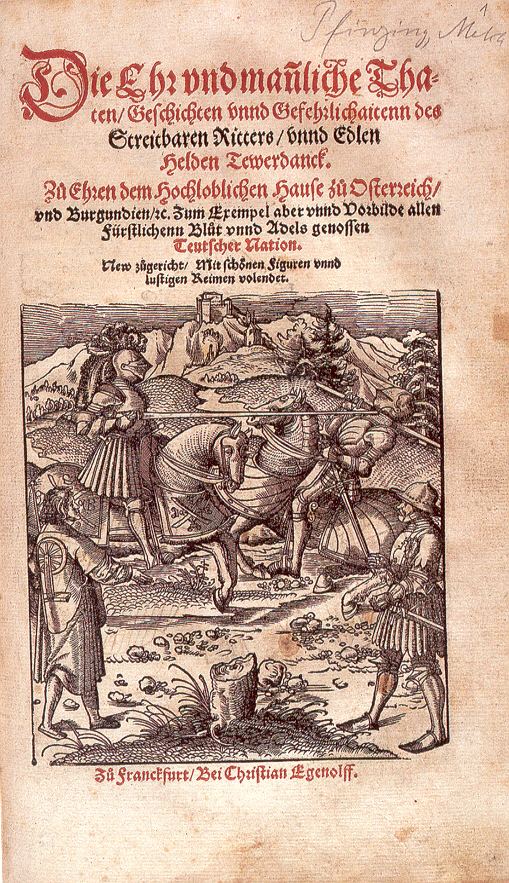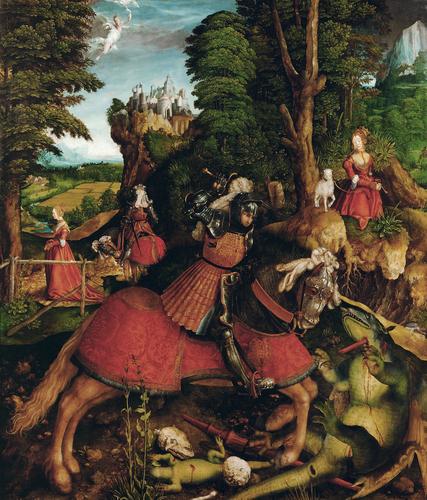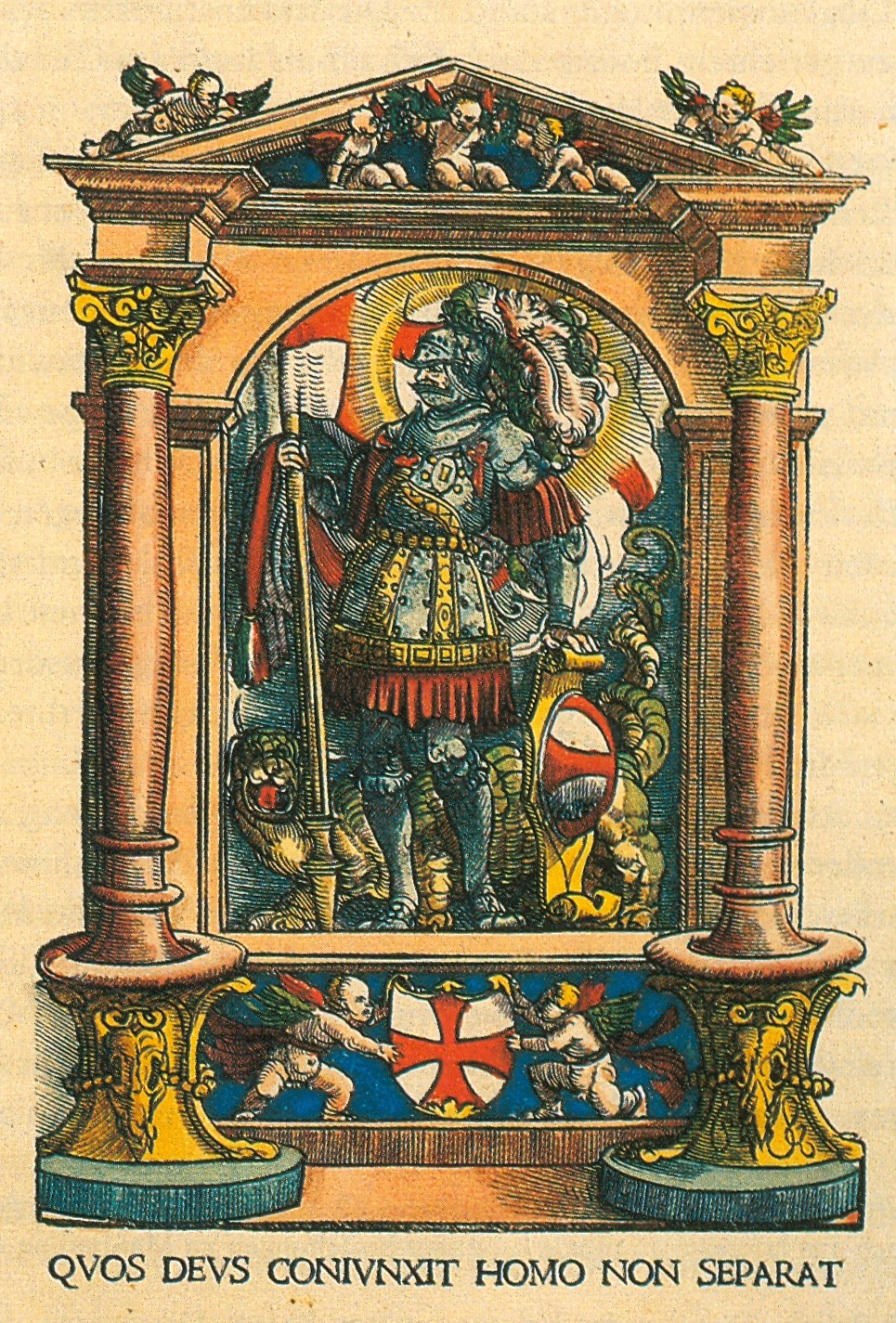|
Triumphal Procession
The ''Triumphal Procession'' (in German, ''Triumphzug'') or ''Triumphs of Maximilian'' is a monumental 16th-century series of woodcut prints by several artists, commissioned by the Holy Roman Emperor Maximilian I. The composite image was printed from over 130 separate wood blocks; a total of 139 are known. Approximately long, it is one of the largest prints ever produced. It was designed to be pasted to the walls in city halls or the palaces of princes to create a decorative frieze, an expression of the Emperor's power and magnificence: a pictorial form of the contemporaneous royal entry, which like many Renaissance entries looked back to the Roman triumph. Maximilian's papers show that he intended the procession to "grace the walls of council chambers and great halls of the empire, proclaiming for posterity the noble aims of their erstwhile ruler". It was one of several works of propaganda in literary and print form commissioned by Maximilian, who was always drastical ... [...More Info...] [...Related Items...] OR: [Wikipedia] [Google] [Baidu] |
Maximilian I, Holy Roman Emperor
Maximilian I (22 March 1459 – 12 January 1519) was King of the Romans from 1486 and Holy Roman Emperor from 1508 until his death. He was never crowned by the pope, as the journey to Rome was blocked by the Venetians. He proclaimed himself Elected Emperor in 1508 (Pope Julius II later recognized this) at Trent, thus breaking the long tradition of requiring a Papal coronation for the adoption of the Imperial title. Maximilian was the son of Frederick III, Holy Roman Emperor, and Eleanor of Portugal. Since his coronation as King of the Romans in 1486, he ran a double government, or ''Doppelregierung'' (with a separate court), with his father until Frederick's death in 1493. Maximilian expanded the influence of the House of Habsburg through war and his marriage in 1477 to Mary of Burgundy, the ruler of the Burgundian State, heir of Charles the Bold, though he also lost his family's original lands in today's Switzerland to the Swiss Confederacy. Through marriage of his son Phil ... [...More Info...] [...Related Items...] OR: [Wikipedia] [Google] [Baidu] |
Theuerdank
''Theuerdank'' (''Teuerdank, Tewerdanck, Teuerdannckh'') is a poetic work composed by Maximilian I, Holy Roman Emperor, the Holy Roman Emperor, Maximilian I, (1486-1519) in German which tells the fictionalised and romanticised story of his journey to marry Mary of Burgundy in 1477. The published poem was accompanied by 118 woodcuts designed by the artists Leonhard Beck, Hans Burgkmair, Hans Leonhard Schäufelein, Hans Schäufelein and others.Bartrum, 147 Its newly designed blackletter typeface was influential. The full title in the first (1517) edition is ''Die geverlicheiten vnd einsteils der geschichten des loblichen streytparen vnd hochberümbten helds vnd ritters herr Tewrdannckhs'' ("The adventures and part of the stories of the praiseworthy, valiant and most famous hero and knight, lord Teuerdank"). Background Maximilian I, Holy Roman Emperor, Maximilian I, and his father Frederick III, Holy Roman Emperor, Frederick III, were part of what was to become a long line of Holy ... [...More Info...] [...Related Items...] OR: [Wikipedia] [Google] [Baidu] |
Cornelis Liefrinck
Cornelis Liefrinck (1581–c. 1662) was a Dutch Golden Age landscape painter. Biography According to Houbraken he was born and lived in Leiden and was still painting in 1640, along with his contemporaries Arnout Elsevier, Jan van Goyen, and Egmont Cornelisz Stooter.Cornelis Liefrinck Biography in ''De groote schouburgh der Nederlantsche konstschilders en schilderessen'' (1718) by Arnold Houbraken, courtesy of the Houbraken may have meant [...More Info...] [...Related Items...] OR: [Wikipedia] [Google] [Baidu] |
Hieronymus Andreae
Hieronymus Andreae, or Andreä, or Hieronymus Formschneider, (died 7 May 1556) was a German woodblock cutter ("formschneider"), printer, publisher and typographer closely associated with Albrecht Dürer. Andreae's best known achievements include the enormous, 192-block Triumphal Arch woodcut, designed by Dürer for Maximilian I, Holy Roman Emperor, and his design of the characteristic German "blackletter" Fraktur typeface ("Gothic" to most English-speakers), on which German typefaces were based for several centuries. He was also significant as a printer of music. In the opinion of Adam von Bartsch, although Andreae never designed woodcuts (as opposed to designing typefaces), the quality of his work was such that he, along with Hans Lützelburger and Jost de Negker, should be considered an artist. Life and work There is some evidence that he matriculated at the University of Leipzig in 1504, although this might also mean that he worked for the university rather than being a stu ... [...More Info...] [...Related Items...] OR: [Wikipedia] [Google] [Baidu] |
Jost De Negker
Jost de Negker (c. 1485–1544) was a cutter of woodcuts and also a printer and publisher of prints during the early 16th century, mostly in Augsburg, Germany. He was a leading "formschneider" or blockcutter of his day, but always to the design of an artist. He is "closely tied to the evolution of the fine woodcut in Northern Europe". For Adam von Bartsch, although he did not usually design or draw, the quality of his work, along with that of Hans Lützelburger and Hieronymus Andreae, was such that he should be considered as an artist. Some prints where the designer is unknown are described as by de Negker, but it is assumed there was an artist who drew the design, although it has been suggested that de Negker might fill in a landscape background to a drawing of a figure. Born in Antwerp c.1485, he worked as a cutter in the Netherlands to 1508, when a print he cut by Lucas van Leyden was published. He probably moved in that year to Augsburg (certainly before 1512) and work ... [...More Info...] [...Related Items...] OR: [Wikipedia] [Google] [Baidu] |
Wolf Huber
The wolf (''Canis lupus''; : wolves), also known as the gray wolf or grey wolf, is a large canine native to Eurasia and North America. More than thirty subspecies of ''Canis lupus'' have been recognized, and gray wolves, as popularly understood, comprise wild subspecies. The wolf is the largest extant member of the family Canidae. It is also distinguished from other ''Canis'' species by its less pointed ears and muzzle, as well as a shorter torso and a longer tail. The wolf is nonetheless related closely enough to smaller ''Canis'' species, such as the coyote and the golden jackal, to produce fertile hybrids with them. The banded fur of a wolf is usually mottled white, brown, gray, and black, although subspecies in the arctic region may be nearly all white. Of all members of the genus ''Canis'', the wolf is most specialized for cooperative game hunting as demonstrated by its physical adaptations to tackling large prey, its more social nature, and its highly advanced ... [...More Info...] [...Related Items...] OR: [Wikipedia] [Google] [Baidu] |
Hans Schäufelein
Hans may refer to: __NOTOC__ People * Hans (name), a masculine given name * Hans Raj Hans, Indian singer and politician ** Navraj Hans, Indian singer, actor, entrepreneur, cricket player and performer, son of Hans Raj Hans ** Yuvraj Hans, Punjabi actor and singer, son of Hans Raj Hans * Hans clan, a tribal clan in Punjab, Pakistan Places * Hans, Marne, a commune in France * Hans Island, administrated by Greenland and Canada Arts and entertainment * ''Hans'' (film) a 2006 Italian film directed by Louis Nero * Hans (Frozen), the main antagonist of the 2013 Disney animated film ''Frozen'' * ''Hans'' (magazine), an Indian Hindi literary monthly * ''Hans'', a comic book drawn by Grzegorz Rosiński and later by Zbigniew Kasprzak Other uses * Clever Hans, the "wonder horse" * ''The Hans India'', an English language newspaper in India * HANS device, a racing car safety device *Hans, the ISO 15924 code for Simplified Chinese script See also *Han (other) *Hans im Glück, a Germa ... [...More Info...] [...Related Items...] OR: [Wikipedia] [Google] [Baidu] |
Leonhard Beck
Leonhard Beck (c. 1480 – 1542) was a painter and designer of woodcuts in Augsburg, Germany. He was the son of Georg Beck, who was active as a miniaturist in Augsburg c. 1490-1512/15. He worked with his father on two Psalters for the Augsburg monastery in 1495. He was an assistant to Hans Holbein the Elder, working on a Holbein altarpiece now in the Städel in Frankfurt am Main in 1500-1501. His most notable work came when he joined the stable of artists, most in Augsburg, used by Emperor Maximilian I for his series of self-propagandising projects in or with woodcut. He was the main designer for the heavily illustrated poem '' Theuerdank'' (1517), producing 77 of the 118 woodcuts, and apparently all the many adjustments Maximilian required for the second edition in 1519. In these, his style often contrasts painfully with those of the better artists whose work he was altering. He designed 126 blocks for ''Der Weisskunig'' and 7 for the ''Triumphal Procession The ''Triumphal ... [...More Info...] [...Related Items...] OR: [Wikipedia] [Google] [Baidu] |
Hans Springinklee
Hans Springinklee (c.1490/c.1495 – c.1540) was a German artist from Nuremberg, best known for his woodcuts.British Museum bio, see refs below. He was a pupil of Albrecht Dürer. Life Little written evidence remains of Springinklee's life, and neither his exact dates of birth or death are known. He was born in Nuremberg between 1490 and 1495, was alive in 1524, and died no later than 1540. In 1547, Johann Neudörffer the Elder wrote that Springinklee had lived with, and learned his craft from, Albrecht Dürer. His first woodcuts date from 1512–1513, but there is no evidence of his presence in Nuremberg after 1524, and it is presumed that he had left Nuremberg by that date. The first documentary evidence dates to 1520, when the council of Nuremberg commissioned him to decorate rooms in Nuremberg Castle before a visit of the Holy Roman Emperor Charles V. On 10 September 1527, his two daughters mentioned that he had left them in Nuremberg three years before, and his f ... [...More Info...] [...Related Items...] OR: [Wikipedia] [Google] [Baidu] |
Albrecht Altdorfer
Albrecht Altdorfer (12 February 1538) was a German painter, engraver and architect of the Renaissance working in Regensburg, Bavaria. Along with Lucas Cranach the Elder and Wolf Huber he is regarded to be the main representative of the Danube School, setting biblical and historical subjects against landscape backgrounds of expressive colours. He is remarkable as one of the first artists to take an interest in landscape as an independent subject. As an artist also making small intricate engravings he is seen to belong to the Nuremberg Little Masters. Biography Altdorfer was born in Regensburg or Altdorf, Lower Bavaria, Altdorf around 1480. He acquired an interest in art from his father, Ulrich Altdorfer, who was a painter and miniaturist. At the start of his career, he won public attention by creating small, intimate modestly scaled works in unconventional media and with eccentric subject matter. He settled in the free imperial city of Regensburg, a town located on the Danube Ri ... [...More Info...] [...Related Items...] OR: [Wikipedia] [Google] [Baidu] |
Hans Burgkmair
Hans Burgkmair the Elder (1473–1531) was a German Painting, painter and woodcut printmaker. Background Hans Burgkmair was born in Augsburg, the son of painter Thomas Burgkmair. His own son, Hans the Younger, later became a painter as well. From 1488, Burgkmair was a pupil of Martin Schongauer in Colmar. Schongauer died in 1491, before Burgkmair was able to complete the normal period of training. He may have visited Italy at this time, and certainly did so in 1507, which greatly influenced his style. From 1491, he worked in Augsburg, where he became a master and eventually opened his own workshop in 1498. Burgkmair was a Lutheran. Career German art historian Friedrich Wilhelm Hollstein ascribes 834 woodcuts to Burgkmair, the majority of which were intended for book illustrations. Slightly more than a hundred are “single-leaf” prints which were not intended for books. His work shows a talent for striking compositions which blend Italian Renaissance forms with the established ... [...More Info...] [...Related Items...] OR: [Wikipedia] [Google] [Baidu] |






.png)


